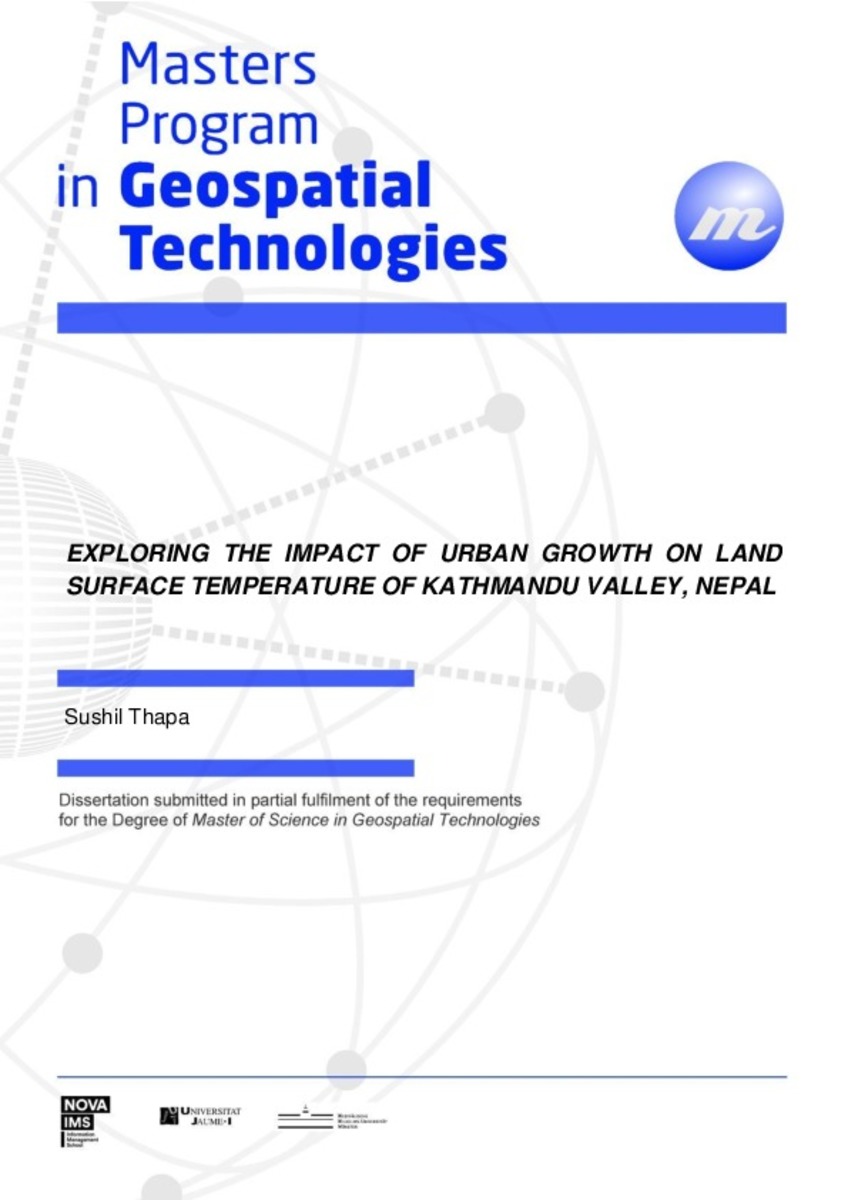Mostrar el registro sencillo del ítem
Exploring the impact of urban growth on land surface temperature of Kathmandu Valley, Nepal
| dc.contributor | Pla Bañón, Filiberto | |
| dc.contributor.author | Thapa, Sushil | |
| dc.contributor.other | Universitat Jaume I. Departament de Llenguatges i Sistemes Informàtics | |
| dc.date.accessioned | 2017-03-31T06:55:15Z | |
| dc.date.available | 2017-03-31T06:55:15Z | |
| dc.date.issued | 2017-03-03 | |
| dc.identifier.uri | http://hdl.handle.net/10234/167031 | |
| dc.description | Treball de Final de Màster Universitari Erasmus Mundus en Tecnologia Geoespacial (Pla de 2013). Codi: SIW013. Curs acadèmic 2016-2017 | ca_CA |
| dc.description.abstract | Kathmandu is experiencing rapid urban growth since last few decades. Cities are expanding across the countryside at the expense of productive land. Such urban sprawl has incurred adverse environmental consequences affecting quality of life of urban residents in the valley. Recently, Kathmandu has been identified to be on the verge of climate change, especially in the context of urban warming. Thus exploring the impact of urban growth on land surface temperature could be an effective means to unveil environmental issues caused by anthropogenic activities. This can be useful for the urban planners in urban planning and management as well as to raise public awareness regarding urban warming effect. Advancement in thermal Remote Sensing, GIS and statistical procedure has enabled monitoring land surface temperature and its correlation to land use and land cover. To analyze such relationship, we performed supervised classification and change detection to determine the spatial trend of land use and land cover change. After that we obtained the spatial pattern of LST using thermal band of Landsat images. Then we applied regression analysis to explore the relationship between surface temperature and land surface characteristics including both land use land cover types and land use and land cover indices. Based upon our analysis, we found that urban area has increased considerably by 259% during the period 1988-2014. The surface temperatures were found to be greater for bare soil and urban land use types. The regression analysis showed positive correlation between urban growth and LST. Finally we found LULC indices based approach better than LULC class for LST prediction. | ca_CA |
| dc.format.extent | 65 p. | ca_CA |
| dc.format.mimetype | application/pdf | ca_CA |
| dc.language.iso | eng | ca_CA |
| dc.publisher | Universitat Jaume I | ca_CA |
| dc.rights | Atribución-NoComercial-CompartirIgual 4.0 España | * |
| dc.rights.uri | http://creativecommons.org/licenses/by-nc-sa/4.0/ | * |
| dc.subject | Màster Universitari Erasmus Mundus en Tecnologia Geoespacial | ca_CA |
| dc.subject | Erasmus Mundus University Master's Degree in Geospatial Technologies | ca_CA |
| dc.subject | Máster Universitario Erasmus Mundus en Tecnología Geoespacial | ca_CA |
| dc.subject | Land Surface Temperature | ca_CA |
| dc.subject | Land use land cover | ca_CA |
| dc.subject | Lansadt | ca_CA |
| dc.subject | Regression analysis | ca_CA |
| dc.subject | Thermal Remote Sensing | ca_CA |
| dc.subject | Urban Heat Island | ca_CA |
| dc.subject | Urban fragmentation | ca_CA |
| dc.subject | Urban Growth | ca_CA |
| dc.title | Exploring the impact of urban growth on land surface temperature of Kathmandu Valley, Nepal | ca_CA |
| dc.type | info:eu-repo/semantics/masterThesis | ca_CA |
| dc.educationLevel | Estudios de Postgrado | ca_CA |
| dc.rights.accessRights | info:eu-repo/semantics/openAccess | ca_CA |
Ficheros en el ítem
Este ítem aparece en la(s) siguiente(s) colección(ones)
-
TFM: Màster Universitari Erasmus Mundus en Tecnologia Geoespacial [79]
SIW013; SIK013








